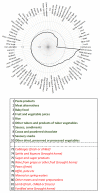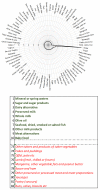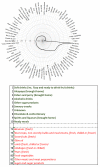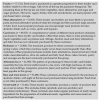Dietary Patterns Derived from UK Supermarket Transaction Data with Nutrient and Socioeconomic Profiles
- PMID: 33925712
- PMCID: PMC8147024
- DOI: 10.3390/nu13051481
Dietary Patterns Derived from UK Supermarket Transaction Data with Nutrient and Socioeconomic Profiles
Abstract
Poor diet is a leading cause of death in the United Kingdom (UK) and around the world. Methods to collect quality dietary information at scale for population research are time consuming, expensive and biased. Novel data sources offer potential to overcome these challenges and better understand population dietary patterns. In this research we will use 12 months of supermarket sales transaction data, from 2016, for primary shoppers residing in the Yorkshire and Humber region of the UK (n = 299,260), to identify dietary patterns and profile these according to their nutrient composition and the sociodemographic characteristics of the consumer purchasing with these patterns. Results identified seven dietary purchase patterns that we named: Fruity; Meat alternatives; Carnivores; Hydrators; Afternoon tea; Beer and wine lovers; and Sweet tooth. On average the daily energy intake of loyalty card holders -who may buy as an individual or for a household- is less than the adult reference intake, but this varies according to dietary purchase pattern. In general loyalty card holders meet the recommended salt intake, do not purchase enough carbohydrates, and purchase too much fat and protein, but not enough fibre. The dietary purchase pattern containing the highest amount of fibre (as an indicator of healthiness) is bought by the least deprived customers and the pattern with lowest fibre by the most deprived. In conclusion, supermarket sales data offer significant potential for understanding population dietary patterns.
Keywords: big data; dietary assessment; dietary patterns; nutrients; nutrition analytics; socioeconomic; transaction data.
Conflict of interest statement
M.A.M. is an inventor and shareholder at Dietary Assessment Ltd., but receives no financial income, and is not involved in the running of the company. B.S. and T.R. are employees at Sainsbury’s.
Figures












Similar articles
-
Exploring the Geographic Variation in Fruit and Vegetable Purchasing Behaviour Using Supermarket Transaction Data.Nutrients. 2021 Dec 30;14(1):177. doi: 10.3390/nu14010177. Nutrients. 2021. PMID: 35011053 Free PMC article.
-
Comparing supermarket loyalty card data with traditional diet survey data for understanding how protein is purchased and consumed in older adults for the UK, 2014-16.Nutr J. 2020 Aug 13;19(1):83. doi: 10.1186/s12937-020-00602-3. Nutr J. 2020. PMID: 32791968 Free PMC article.
-
Consumers' Response to an On-Shelf Nutrition Labelling System in Supermarkets: Evidence to Inform Policy and Practice.Milbank Q. 2017 Sep;95(3):494-534. doi: 10.1111/1468-0009.12277. Milbank Q. 2017. PMID: 28895220 Free PMC article.
-
Supermarket Transaction Records In Dietary Evaluation: the STRIDE study: validation against self-reported dietary intake.Public Health Nutr. 2023 Dec;26(12):2663-2676. doi: 10.1017/S1368980023001842. Epub 2023 Sep 6. Public Health Nutr. 2023. PMID: 37671553 Free PMC article.
-
A systematic review of supermarket automated electronic sales data for population dietary surveillance.Nutr Rev. 2022 May 9;80(6):1711-1722. doi: 10.1093/nutrit/nuab089. Nutr Rev. 2022. PMID: 34757399 Free PMC article.
Cited by
-
Dietary Fibre Intervention for Gut Microbiota, Sleep, and Mental Health in Adults with Irritable Bowel Syndrome: A Scoping Review.Nutrients. 2021 Jun 23;13(7):2159. doi: 10.3390/nu13072159. Nutrients. 2021. PMID: 34201752 Free PMC article.
-
Overcoming biases of individual level shopping history data in health research.NPJ Digit Med. 2024 Sep 30;7(1):264. doi: 10.1038/s41746-024-01231-4. NPJ Digit Med. 2024. PMID: 39349949 Free PMC article. Review.
-
Exploring the Geographic Variation in Fruit and Vegetable Purchasing Behaviour Using Supermarket Transaction Data.Nutrients. 2021 Dec 30;14(1):177. doi: 10.3390/nu14010177. Nutrients. 2021. PMID: 35011053 Free PMC article.
-
Relative validity of an intelligent ordering system to estimate dietary intake among university students from a medical school in Shanghai, China.Int J Behav Nutr Phys Act. 2024 Jul 4;21(1):70. doi: 10.1186/s12966-024-01619-1. Int J Behav Nutr Phys Act. 2024. PMID: 38965619 Free PMC article.
-
Product promotions in online supermarkets: prevalence of 'High Fat Sugar Salt' (HFSS) products and labelling characteristics.Public Health Nutr. 2023 Nov;26(11):2607-2618. doi: 10.1017/S1368980023001787. Epub 2023 Aug 22. Public Health Nutr. 2023. PMID: 37606051 Free PMC article.
References
-
- National Food Strategy . National Food Strategy—Part One. Department for Environment, Food & Rural Affairs; London, UK: 2020.
-
- World Health Organisation Healthy Diet Factsheet. [(accessed on 1 February 2021)];2020 Available online: https://www.who.int/news-room/fact-sheets/detail/healthy-diet.
-
- Iddir M., Brito A., Dingeo G., Del Campo S.S.F., Samouda H., La Frano M.R., Bohn T. Strengthening the Immune System and Reducing Inflammation and Oxidative Stress through Diet and Nutrition: Considerations during the COVID-19 Crisis. Nutrients. 2020;12:1562. doi: 10.3390/nu12061562. - DOI - PMC - PubMed
-
- Butland B., Jebb S., Kopelman P., McPherson K., Thomas S., Mardell J., Parry V. Tackling Obesities: Future Choices-Project Report. Volume 10 Department of Innovation, Universities and Skills; London, UK: 2007.
-
- Parsons K., Hawkes C., Wells R. A Food Policy Perspective, in Rethinking Food Policy: A Fresh Approach to Policy and Practice. Centre for Food Policy; London, UK: 2019. Brief 2. What is the Food System?
MeSH terms
Grants and funding
LinkOut - more resources
Full Text Sources
Other Literature Sources

